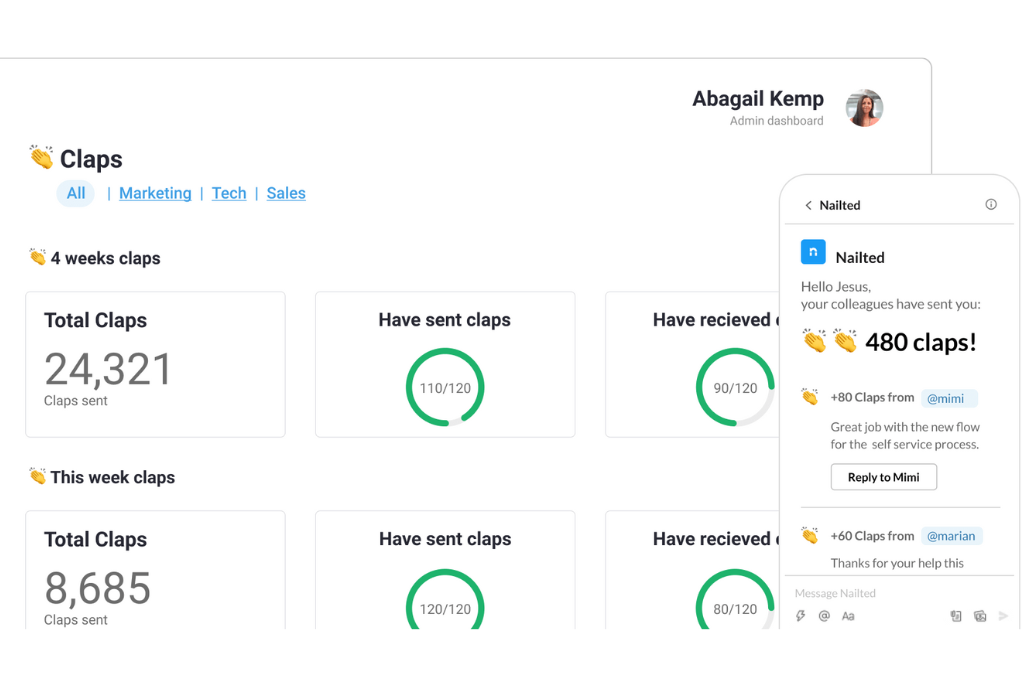There are numerous factors that play a key role in improving the employee experience. They are known as drivers of employee engagement. These are the factors that make an employee feel more engaged with the company. These factors, given the importance they have, allow us to improve employee engagement in the workplace.
Don’t overlook them and explore with us the intricacies of employee engagement. In this article we unveil the 22 drivers of employee engagement that take center stage in crafting a culture where employees find fulfillment and purpose in their day-to-day work.
Why are the drivers of employee engagement important?
Before diving into the 22 drivers of employee engagement we must understand that these drivers are not mere checkboxes on “the great employee experience checklist”. They are the catalysts that help any organization achieve success through their most valuable asset, their employees.
What makes them so important?
- Increased productivity: when employees find purpose in their work, their commitment to delivering quality results intensifies. Working on engagement fosters a sense of ownership and responsibility, driving employees to go above and beyond in their roles.
- Reduced turnover: employees who feel valued, heard, and connected to their company are less likely to seek opportunities elsewhere. This not only saves the organization the costs associated with turnover but also fosters continuity and institutional knowledge.
- Innovation and creativity: engagement acts as a booster for innovation and creativity. When employees feel empowered to express their ideas, take risks, and explore, the company becomes a breeding ground for innovative solutions.
- Positive workplace culture: strive to be like those companies that prioritize transparent communication, effective leadership, and continuous development. Promoting this atmosphere, where employees feel supported and motivated, enhances their sense of belonging.
- Adaptability and resilience: employee engagement drivers, such as opportunities for learning and development, foster a culture of adaptability. Engaged employees are more likely to adapt to change in a positive way, driving the company forward in times of uncertainty.
- Customer satisfaction: when employees have a passion for their work and a strong connection to the company, their enthusiasm naturally spreads. Their enthusiasm extends not only to their colleagues, but also to their interactions with customers. This, in turn, improves the overall customer experience and customer loyalty.
- Health and well-being: a company that prioritizes engagement reflects a healthier work-life balance, reducing stress and burnout. This has a positive effect on the physical and mental health of employees.
As People & Culture professionals, working on employee engagement is not just a task. It’s a commitment to building a workplace where the employees flourish, the company thrive, and the journey to success becomes a collective and rewarding experience. Measure your current employee engagement level and acknowledge these 22 drivers of employee engagement to set the foundation for a successful People strategy.
The 22 drivers of employee engagement
By understanding the influence of the 22 drivers of employee engagement, People & Culture professionals can empower organizations to cultivate high-performing and engaged teams. Start crafting an employee experience where every employee not only feels that they belong to the organization, but actively contributes to its success.
These are the 22 drivers of employee engagement:
- Job satisfaction
- Corporate values
- Work environment
- Feedback and communication
- Leadership and fellowship
- Employee recognition
- Professional development
- Sense of belonging
- Transparency and fairness
- Workload
- Clarity of expectations
- Empowerment
- Autonomy
- Purpose
- Work-life balance
- Inclusivity
- Collaboration
- Innovation
- Psychological safety
- Positive mental health
- Flexible work
- Wellbeing

1. Job satisfaction
Job satisfaction is one of the most critical drivers of employee engagement. Both concepts create a symbiotic relationship where satisfied employees are more likely to be engaged, and engaged employees are more likely to be satisfied. This is explained if we delve deeper into it; when employees feel fulfilled in their roles, they are generally more committed, motivated, and productive. And this is exactly what reflects an increased level of engagement.
It is important to note that this commitment positively influences the culture and work environment in general, fostering a sense of belonging, which we will discuss later. Related to the same argument, satisfied employees are more likely to speak positively about their company. This contributes highly to creating a positive employer brand, helping a lot in attracting new talent.
How can we increase job satisfaction so that it has an impact on employee engagement?
Here are some ideas you can explore:
- Provide opportunities for skill and career development.
- Recognize employees for their good work with positive feedback.
- Implement performance-based incentives.
- Ensure fair and equal compensation among all employees.
- Open channels for ongoing communication.
2. Corporate values
Strong and well-defined corporate values provide a clear framework that guides behavior, decision-making, and company culture. When employees align with their corporate values, their feelings of purpose, connection, and pride in their work, increase, resulting in heightened engagement.
When defining yours, bear in mind that the importance of corporate values lies in their ability to create a shared identity, foster a positive culture, and contribute to team motivation.
How can we work on and instill our corporate values so that they have an impact on employee engagement?
Here are some ideas you can explore:
- Communicate and reinforce your values regularly through different channels; meetings, internal communication channels, team building activities, events, etc.
- Recognize employees for working and acting in line with corporate values.
- Integrate your values into training programs for new employees.
- Ensure managers serve as role models for their teams.
- Use ad hoc reviews to measure value alignment among employees.
3. Work environment
A positive work environment establishes the foundation for a culture where employees feel supported, motivated, and inspired. Having a positive work environment fosters a sense of belonging and commitment to their work and the company.
A positive atmosphere not only attracts top talent but also increases the engagement of existing employees, leveraging their motivation and performance.
How can we work on creating a positive work environment so that it has an impact on employee engagement?
Here are some ideas you can explore:
- Open communication channels for employees ensuring they feel heard and valued.
- Offer flexibility, promoting a healthy work-life balance, which we’ll talk about later.
- Empower employees providing opportunities for career growth.
- Foster a collaborative culture where employees help each other.
- Involve employees in decision-making processes to bring them closer to company success.
4. Feedback and communication
Regular and constructive feedback empowers employees, providing clarity on their performance and contributions. Moreover, opening communication channels create an environment where ideas, necessities and concerns are shared and addressed. It comes without saying that it makes employees feel valued and heard.
How can we promote feedback and communication to impact positively on employee engagement?
Here are some ideas you can explore:
- Create the habit of positive feedback implementing an employee recognition program.
- Conduct regular performance reviews that provide constructive feedback on individual contributions.
- Encourage an open-door policy ensuring employees feel comfortable approaching their managers with ideas and concerns.
- Provide communication training for managers to enhance their skills in giving feedback and conflict-solving.
- Launch regular employee engagement surveys to gather anonymous feedback.
5. Leadership and fellowship
Strong leadership provides direction, support, and inspiration to employees. Managers serving as a role model foster a sense of purpose and alignment among team members. At the same time, a positive fellowship contributes to a collaborative and supportive workplace, creating a sense of community that enhances motivation, satisfaction and engagement.
How can we promote good leadership and fellowship to impact positively on employee engagement?
Here are some ideas you can explore:
- Encourage managers to adopt the corporate values and behaviors expected from employees, serving as role models for professionalism and commitment.
- Emphasize the importance of clear and transparent communication, ensuring that managers are always accessible for discussions.
- Organize team-building activities that promote a sense of belonging among team members. You can also do it remotely.
- Encourage managers to conduct regular 1:1 meetings with their team members to discuss goals and provide constructive feedback.
- Make sure employees are involved in all decision-making processes, fostering a sense of inclusion.
6. Employee recognition
When employees feel valued and appreciated for their work, it enhances their sense of purpose and belonging to the organization. Recognition is a strong tool for any company as it not only boosts morale but also reinforces desired behaviors.
31.3% of employees claim the need for more recognition. As People & Culture professionals we must understand that fostering a culture of appreciation and achievement is highly rewarding for anyone involved in the process. Moreover, it positively impacts job satisfaction, productivity, and overall employee engagement.
How can we make recognition a habit in our companies to impact positively on employee engagement?
Here are some ideas you can explore:
- Implement a recognition system for regular and timely positive messages among employees; create the habit.
- Acknowledge employees’ milestones such as significant accomplishments or even work anniversaries.
- Provide training for managers on the importance of recognizing their team efforts and give them the necessary tools to do so.
- Establish reward programs to provide tangible incentives for outstanding performance.
- Celebrate achievements publicly announcing them in meetings, internal newsletters, or other internal communication channels.

7. Professional development
When employees have access to opportunities to learn new skills and reinforce the ones they have, it not only boosts their confidence and job satisfaction but also instills a sense of loyalty and engagement. Fostering continuous learning empowers employees to contribute meaningfully to their roles.
How can we offer professional development opportunities to impact positively on employee engagement?
Here are some ideas you can explore:
- Prepare ad hoc career development plans, provide regular training programs, or access to online learning platforms.
- Provide financial support for employees to access professional courses or certifications.
- Offer flexible schedules for employees pursuing further education.
- Establish mentorship programs that pair experienced employees with those seeking career growth.
- Promote cross-functional training, allowing employees to broaden their skills on different aspects of the organization.
8. Sense of belonging
A strong sense of belonging fosters a positive company culture, improves collaboration, and contributes to overall job satisfaction. When employees feel a strong connection to their workplace, colleagues, and the company mission and values, they are more likely to put more effort in everything they do, leading to increased engagement and commitment.
How can we enhance the sense of belonging among employees to impact positively on employee engagement?
Here are some ideas you can explore:
- Design a welcoming onboarding process that helps new employees integrate seamlessly into the company culture.
- Organize regular team-building activities to strengthen employee relationships.
- Ensure that communication is always inclusive and diverse.
- Offer a flexible schedule to facilitate employees coping with responsibilities out of work.
- Offer wellness programs to create a supportive environment that cares for employees beyond their professional roles.
9. Transparency and fairness
Prioritizing open communication, equitable opportunities, and fair treatment, fosters a sense of justice and inclusion, crucial for building a positive workplace culture. Employees are more likely to be engaged when they perceive that decisions are made transparently and that they are treated fairly. This, in turn, enhances their engagement, motivation, and overall job satisfaction.
How can we work on transparency and fairness to impact positively on employee engagement?
Here are some ideas you can explore:
- Foster transparent communication through regular updates and organizing meets to ensure all employees are in the same line.
- Set clear expectations for performance and goals, making sure employees understand what is expected of them.
- Implement diversity and inclusion programs to promote a fair and inclusive workplace.
- Consider talking transparently about salaries. Provide clear explanations about how these are defined and increased.
- Establish a protocol to ensure that conflicts are addressed in an unbiased and transparent manner.
10. Workload
When employees face manageable workloads, it’s more likely that they’ll maintain a healthy work-life balance, experience less stress, and remain engaged in their roles. An excessive workload can lead to burnout, decreased motivation and productivity. This has a direct negative impact on employee engagement and overall performance.
How can we reduce workload to avoid it having a negative impact on employee engagement?
Here are some ideas you can explore:
- Encourage managers to conduct regular 1:1 meetings to ensure that employees have realistic workloads and that these are aligned with company goals.
- Provide training on time management, effective task prioritization and planning to help employees better handle their responsibilities.
- Implement flexible working options to provide employees with more control over their work hours.
- Promote the use of automation tools to carry out repetitive tasks, reducing the manual workload on employees.
- Communicate clear expectations regarding responsibilities to prevent misunderstandings that could lead to excessive workloads.
11. Clarity of expectations
Some companies overlook the importance of providing employees with a roadmap for their roles and responsibilities. When expectations are well-defined, employees gain a sense of purpose and direction about their contributions to the company. Setting clear expectations enhances motivation, accountability, and overall job satisfaction, contributing positively to employee engagement.
How can we set clear expectations to avoid negatively affecting employee engagement?
Here are some ideas you can explore:
- Start from the very beginning. Craft accurate job descriptions explaining in detail roles, responsibilities and expectations.
- Encourage managers to set employee goals in collaboration with them.
- Align employees around company goals with OKRs. In this way, everyone will have a way to objectively measure their performance.
- Establish communication channels for employees to seek clarification and raise concerns on expectations.
- Launch performance reviews to allow employees to receive constructive feedback on their performance and fulfillment of expectations.
12. Empowerment
Allow employees to have the autonomy to make decisions, take ownership of their work, and see the impact of their contributions. By doing this, you will enhance their sense of purpose and fulfillment. Empowered employees are more likely to be engaged in driving organizational success.
How can we foster employee empowerment to positively impact employee engagement?
Here are some ideas you can explore:
- Encourage managers to delegate new tasks and responsibilities to their team members, allowing them to take on new challenges.
- Promote an environment where employees are free to make decisions within their areas of expertise.
- Invest in ongoing development programs.
- Encourage employees to share their ideas, concerns, and feedback without fear of reprisal.
- Conduct workshops on empowerment and self-leadership to equip employees with the skills needed for autonomy.
13. Autonomy
Promoting autonomy empowers individuals to take ownership of their work, make decisions, and contribute meaningfully to company goals. Autonomy provides employees with the freedom to use their skills, creativity, and judgment, fostering a sense of purpose and accomplishment. When individuals have the autonomy to shape their roles and decide how to fulfill their tasks, it not only boosts their confidence but also creates a more engaged, innovative, and committed workforce.
How can we foster employee autonomy to positively impact employee engagement?
Here are some ideas you can explore:
- Offer remote work and flexible work schedules, allowing employees to manage their time in a way that suits their preferences.
- Encourage managers to allow employees to take ownership from planning to execution of tasks.
- Collaboratively set measurable goals, giving employees the autonomy to contribute to corporate goals.
- Provide development opportunities, enabling employees to enhance their skills and take on more challenging tasks.
- Open forums where employees can propose and implement innovative ideas.
14. Purpose
Ensuring that every employee has a clear sense of purpose aligns individual roles with company goals. When employees understand the importance and role of their contributions, they feel a sense of meaning, motivation, and fulfillment in their work. A strong sense of purpose not only enhances job satisfaction but also fosters a deeper commitment to the company mission and values.
How can we promote a sense of purpose among employees to positively impact employee engagement?
Here are some ideas you can explore:
- Make sure that each employee’s role is clearly defined.
- Ensure that employee contributions align with the company mission and goals.
- Encourage employees to provide feedback on company goals and strategies, fostering a sense of ownership and shared purpose.
- Emphasize the collective purpose reinforcing the company mission and values through ongoing communication.
- Engage employees in corporate social responsibility initiatives. This will highlight the positive impact the company can have on the community or the environment.
15. Work-life balance
When companies prioritize work-life balance, employees experience reduced stress, increased motivation and a greater sense of control over their lives. This not only contributes to improved mental health, but also fosters a positive work environment, which translates into greater employee engagement.
How can we promote a healthy work-life balance that positively impacts employee engagement?
Here are some ideas you can explore:
- Offer flexible work hours to accommodate personal commitments to work schedules.
- Implement remote work policies, allowing employees to work from wherever they prefer to better manage their work and personal responsibilities.
- Set clear expectations, preventing employees from feeling overwhelmed and stressed.
- Implement wellness initiatives such as fitness programs, mental health sessions, and stress management workshops.
- Establish guidelines for after-hours communication, preventing employees from feeling the need to be constantly connected.
16. Inclusivity
An inclusive workplace promotes every individual to feel valued, respected, and an equal part of the whole. Inclusive workplaces foster a sense of belonging, which encourages collaboration, teamwork and fellowship. Employees who feel that their unique perspectives and conditions are acknowledged are more likely to do their best in their roles and work hard for the success of the company.
How can we foster an inclusive workplace that positively impacts employee engagement?
Here are some ideas you can explore:
- Provide training on diversity and inclusion to increase awareness among employees.
- Define and launch policies that help create a discrimination-free workplace, promoting equal opportunities and a fair treatment.
- Promote the use of inclusive language in the workplace to create a more welcoming and respectful environment.
- Don’t forget to celebrate cultural events and holidays from all ethnicities and minority groups, as well as the ones that your company already celebrates.
- Ensure that workplace facilities are accessible to all employees with different accessibility needs.
17. Collaboration
Collaboration fosters a sense of shared purpose and collective achievement within the workplace. When employees collaborate effectively with each other, they experience an increased sense of belonging, and a deeper commitment to meet company goals. Collaborative environments encourage diverse perspectives, the exchange of ideas and mutual support, leading to a positive company culture.
How can we foster collaboration in the workplace to positively impact employee engagement?
Here are some ideas you can explore:
- Organize cross-functional teams to bring together employees from different teams to work on specific projects together.
- Implement digital collaboration tools that facilitate communication and project management, especially during remote work.
- Prepare team-building activities to strengthen interpersonal relationships and foster a collaborative spirit.
- Establish goals that require collaboration, emphasizing the collective achievements of teams.
- Provide opportunities for cross-training, allowing employees to learn about different roles and responsibilities within the company.
- Use collaborative timesheets with standardized templates where team members can log their hours on shared projects, fostering transparency and a sense of collective responsibility.
18. Innovation
Foster a dynamic and forward-thinking workplace culture where employees are encouraged to contribute innovative ideas. Employees will feel a sense of purpose, autonomy, and pride in their work. Bear in mind that innovation not only stimulates creativity but also provides employees with opportunities to make meaningful contributions to the company. This leads to increased job satisfaction and a deeper connection to the company goals.
How can we foster innovation in the workplace to positively impact employee engagement?
Here are some ideas you can explore:
- Foster collaboration between employees from different teams to encourage diverse perspectives and innovative solutions.
- Organize innovation challenges to engage employees in solving specific business problems.
- Cultivate a culture that supports calculated risk-taking. Encourage employees to feel comfortable proposing new ideas without fear of failure.
- Dedicate specific days for employees to explore new concepts and initiatives.
- Implement platforms where employees can submit and discuss their new ideas.
19. Psychological safety
Psychological safety fosters an environment where individuals feel safe to express their thoughts and take risks. Employees who work in a psychologically safe workplace are more likely to share their ideas and collaborate with others.
How can we promote psychological safety in the workplace to positively impact employee engagement?
Here are some ideas you can explore:
- Encourage managers to show themselves as an open, approachable and transparent leader.
- Encourage managers to conduct regular 1:1 meetings with employees to discuss their needs and concerns in a confidential and supportive setting.
- Implement channels for anonymous feedback to encourage employees to share suggestions without fear of reprisal.
- Provide training on conflict resolution to help employees address interpersonal issues in a constructive manner.
- Foster a culture that views failures as learning opportunities, reducing fear and promoting a growth mindset.
20. Positive mental health
Positive mental health directly influences employees wellbeing, motivation, and overall job satisfaction. When employees experience positive mental health, they are more likely to be engaged, remain productive, and increase commitment to their roles.
A workplace that prioritizes mental health fosters a positive and supportive environment. Moreover it also contributes to a culture of empathy and understanding. Engaged employees, who feel their mental health is valued, are more likely to thrive both personally and professionally.
How can we promote positive mental health in the workplace to positively impact employee engagement?
Here are some ideas you can explore:
- Promote regular breaks during the day to prevent burnout.
- Encourage managers to conduct regular 1:1 meetings with employees to discuss their needs and concerns.
- Implement flexible work schedules or remote work options, and make sure everyone is taking holidays.
- Provide employees with access to counseling services to address mental health concerns.
- Implement wellness programs that focus on mental health, like mindfulness sessions, yoga classes, or stress management workshops.
21. Flexible work
Offering flexibility to employees acknowledges the importance of work-life balance, autonomy, and individual wellbeing, concepts mentioned above. Employees who have the chance to manage their work in a way that suits their lifestyles are more likely to feel valued, motivated, and engaged.
How can we offer flexible work options to employees to positively impact employee engagement?
Here are some ideas you can explore:
- Allow employees to work remotely, providing the freedom to work where they prefer.
- Implement flexible work hours, enabling employees to tailor their schedules.
- If possible, provide part-time work options for those employees who need to reduce hours.
- Implement unlimited paid time off, emphasizing trust in employees to manage their time effectively.
- Shift focus to task-based work rather than fixed hours.
22. Wellbeing
Wellbeing refers to the physical, mental, and emotional health of employees within the workplace. When companies prioritize employee wellbeing, they show a commitment to creating a supportive environment, which in turn makes employees feel more emotionally invested in their roles.
How can we work on employee wellbeing to positively impact employee engagement?
Here are some ideas you can explore:
- Conduct annual health screenings for early detection of health issues.
- Ensure ergonomic workstations to prevent discomfort.
- Organize fitness challenges to encourage physical activity.
- Provide access to healthy snack options.
- Promote regular breaks and discourage excessive overtime.
After having explored the 22 drivers of employee engagement, it becomes evident that fostering a thriving work environment requires a multifaceted approach. Each employee engagement driver contributes uniquely to the creation of a workplace where employees are not only satisfied but deeply engaged in their roles.
From promoting work-life balance and autonomy to prioritizing mental health, inclusivity, and wellbeing, organizations have a wide range of employee engagement strategies to start from. Recognize the interplay between these drivers of employee engagement and tailor initiatives that best suit your culture and the needs of your workforce. Remember that it’s not a one-size-fits-all approach.
Employee engagement is not only about productivity; it’s about creating a workplace where employees feel appreciated, heard, and motivated to give their best. Start embracing these 22 drivers of employee engagement to create a company where individuals find purpose, connection, and fulfillment.










